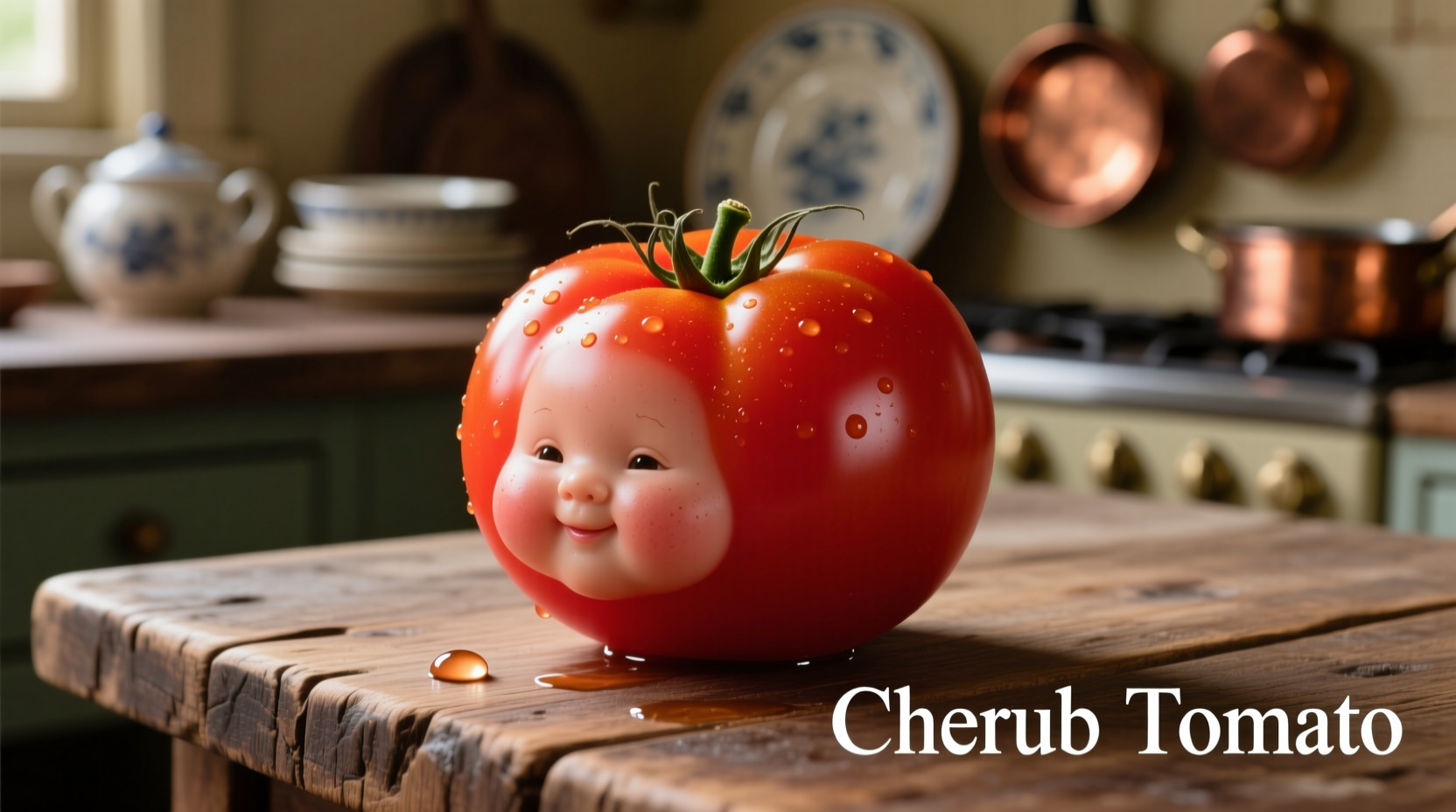What Makes Cherub Tomatoes Unique Among Cherry Varieties
When you're browsing the produce section, cherub tomatoes stand out from regular cherry tomatoes with their distinctive elongated shape. Unlike the perfectly round cherry tomatoes you're accustomed to, cherubs resemble tiny rugby balls with a subtle pointed end. This unique shape isn't just aesthetic—it correlates with their exceptional sweetness profile.
Developed through careful selective breeding, cherub tomatoes (Solanum lycopersicum 'Cherub') belong to the cocktail tomato category. Their sugar content typically measures between 9-11 Brix, significantly higher than the 5-7 Brix of standard cherry tomatoes. This natural sweetness makes them particularly appealing to children and those who find regular tomatoes too acidic.
| Tomato Variety | Shape | Average Brix (Sweetness) | Seeds per Fruit | Best Culinary Use |
|---|---|---|---|---|
| Cherub | Oval/egg-shaped | 9-11 | 15-20 | Raw consumption, salads |
| Standard Cherry | Spherical | 5-7 | 30-40 | Cooking, sauces |
| Grape | Oblong | 7-9 | 20-25 | Roasting, drying |
Development Timeline of Modern Cherry Tomato Varieties
The journey to today's cherub tomatoes spans decades of selective breeding. Understanding this evolution helps explain why cherubs offer such distinctive qualities compared to their ancestors:
- Pre-1970s: Traditional cherry tomatoes were primarily round, prone to cracking, and had inconsistent sweetness
- 1970-1990: Introduction of the first improved cherry varieties with better disease resistance but still limited sweetness
- 1990-2000: Development of grape tomatoes with thicker skins for better shipping characteristics
- Early 2000s: Breeders began focusing on sugar content, creating the first oval-shaped sweet cherry varieties
- 2010s: Commercial introduction of cherub-type tomatoes with consistent high Brix levels and crack resistance
- Present: Cherub tomatoes represent the current standard for sweet, snackable cherry tomatoes in major grocery chains
Optimal Growing Conditions for Cherub Tomatoes
Whether you're considering growing cherub tomatoes in your garden or simply want to understand why they command premium pricing, knowing their specific requirements provides valuable context. These tomatoes thrive under particular conditions that affect their availability and quality.
Cherub tomatoes require 10-12 hours of direct sunlight daily to develop their characteristic sweetness. Unlike standard tomatoes that can produce acceptable fruit with 6-8 hours of sun, cherubs need extended light exposure to maximize sugar production. Temperature is equally critical—they perform best when daytime temperatures stay between 75-85°F (24-29°C) with nighttime temperatures above 60°F (15°C).
Commercial growers using controlled environment agriculture report significantly higher success rates with cherub varieties. According to research from the University of California Agriculture and Natural Resources (UCANR Publication 8513), cherub tomatoes require more precise irrigation management than standard varieties, needing consistent moisture without overwatering to prevent fruit splitting.
Practical Culinary Applications
Cherub tomatoes shine in applications where their natural sweetness and texture can be appreciated without cooking. Their thicker skin and lower moisture content compared to regular cherry tomatoes make them exceptionally versatile:
- Snacking: Perfect as standalone snacks, especially for children's lunchboxes as they resist bruising better than standard cherry tomatoes
- Salads: Add without担心 excess moisture diluting dressings—try them in caprese salads with fresh basil and mozzarella pearls
- Roasting: Roast at 300°F for 45 minutes to concentrate flavors for pasta dishes
- Cold appetizers: Skewer with cubes of halloumi cheese and wrap in prosciutto for elegant hors d'oeuvres
Avoid using cherub tomatoes in applications requiring high liquid content, such as tomato sauces or soups. Their lower water content means they won't break down properly for these uses. For best results, enjoy them raw or with minimal cooking to preserve their delicate sweetness.

Nutritional Profile and Health Benefits
Cherub tomatoes deliver impressive nutritional benefits in their small packages. A one-cup serving (approximately 149g) contains:
- Only 27 calories
- 18% of your daily vitamin C needs
- 20% of your recommended vitamin A
- Significant lycopene content (enhanced when paired with healthy fats)
- 2 grams of dietary fiber
The USDA National Nutrient Database confirms that cherry tomato varieties like cherubs contain higher concentrations of certain antioxidants compared to larger tomato types. Their small size means you consume more skin relative to flesh, and since many beneficial compounds are concentrated in the skin, this makes cherubs particularly nutrient-dense.
Where to Find and How to Select Cherub Tomatoes
Cherub tomatoes have become widely available in major grocery chains across North America and Europe, typically labeled as "Cherub" or "Sweet Cherubs." They're most commonly found in the specialty tomato section alongside other cherry and grape varieties.
When selecting cherub tomatoes, look for these quality indicators:
- Bright, uniform color (typically deep red, though yellow varieties exist)
- Firm texture with slight give when gently squeezed
- Intact stems—avoid those with broken stems which indicate rough handling
- Plump appearance without wrinkles or soft spots
Unlike standard cherry tomatoes that continue ripening after harvest, cherubs are typically vine-ripened and won't sweeten further once picked. This means they're best enjoyed within 3-5 days of purchase. Store them at room temperature away from direct sunlight, and never refrigerate as cold temperatures destroy their delicate flavor compounds.
Troubleshooting Common Cherub Tomato Challenges
While cherub tomatoes are relatively easy to grow, they do present some specific challenges that differ from standard tomato varieties:
- Fruit cracking: Their thin skin makes them susceptible to cracking during irregular watering patterns—maintain consistent moisture levels
- Blossom end rot: More common in cherubs due to their rapid growth—ensure consistent calcium availability in soil
- Pest vulnerability: Their high sugar content attracts more pests—use organic pest control methods early in the season
- Lower yields: Cherub plants typically produce 20-30% less fruit than standard cherry varieties—compensate by planting more plants
According to Cornell University's Vegetable MD Online resource (Cornell Vegetable Newsletter, April 2020), cherub tomatoes require more frequent harvesting than standard varieties because they can quickly become overripe on the vine due to their high sugar content.











 浙公网安备
33010002000092号
浙公网安备
33010002000092号 浙B2-20120091-4
浙B2-20120091-4